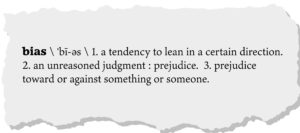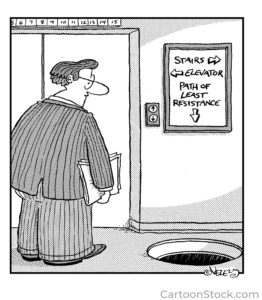Surgery vs non-surgical intervention -Decision for musculoskeletal pain syndrome

When deciding whether to proceed with irreversible intervention such as elective or discretionary orthopedic surgery it is essential to consider the biases of the surgeon, non-surgical healthcare provider, and the patient.
For many orthopedic injuries especially nontraumatic or less acute musculoskeletal pain syndromes surgery can be an intervention option. For many if not most musculoskeletal pain problems surgery can be discretionary or an elective procedure. There are many non-surgical options with less risk of adverse effects that can positively alleviate pain and restore function.
When surgical intervention is one of several treatment options a standard practice is a stepped-care model of providing intervention. Step-care intervention is using the most effective, yet least resource-intensive treatment as the initial option. Only stepping up to more specialized intensive, and potentially risky intervention as clinically required. This model assumes surgery carries greater risk than non-surgical intervention. When it comes to musculoskeletal pain syndromes this is a good approach.
The aim is to have the right provider, delivering the right care, at the right time.

Professional association guidelines (and here) recommend high-quality non-surgical care for many painful musculoskeletal problems before considering surgery. For some musculoskeletal pain syndromes, high-quality physical therapy alone is equally appropriate and effective as Physical Therapy and surgical interventions.
What does peer-reviewed evidence tell us?
Soren Skou and colleagues published a systematic review and meta-analysis of 100-peer reviewed randomized controlled clinical trials comparing the benefits and harms of interventions with and without surgery for non-fracture musculoskeletal conditions. The outcome measures they examined were pain and function. The musculoskeletal pain syndromes included nine regions of the body, and twenty-eight different conditions, such as neck pain; shoulder rotator cuff problems; tennis elbow; carpal tunnel; back pain; osteoarthritis hip/knee; and Achilles tendon rupture.
The conclusions of the investigators are:
- In most musculoskeletal conditions when sufficient data on pain and function are available there are no clinically relevant differences in outcomes between intervention with and without surgery.
- For most conditions with sufficient data on pain and function on serious adverse events, there were no differences in the risk of serious adverse events and death
- Best practice nonsurgical interventions are a viable alternative to surgery for many musculoskeletal conditions.
The literature review provides amalgamated data. Surgical decisions are and should be individualized and made on a case-by-case basis.

Bias
Abraham Maslow, a noted psychologist, said “if the only tool you have is a hammer you tend to see every problem as a nail.”
When deciding between surgical intervention, non-surgical intervention, and a stepwise approach of non-surgical stepping to surgery when non-surgical interventions fail for musculoskeletal pain syndrome it is important to recognize all parties in the decision come with biases.
Explicit biases, surgeons are more inclined to offer a surgical solution, and Physical Therapists are more likely to recommend a non-surgical, and non-surgical stepwise intervention.
Patients come to the decision process with their own biases. Patients can incline “nothing other than surgery will cure the problem,” or “avoid at all costs medication and surgery.”
Implicit unconscious biases are more challenging to recognize and address.
Reflective questions a patient can ask surgeons, non-surgical orthopedic specialists, and self to address potential biases to assure seeing the right provider, and delivering the right care, at the right time are:
- Should I be seeing a surgeon and/or a non-surgeon orthopedic specialist for this problem? (Right provider)
- Other than my reports of pain how will you measure if I am getting better? (Right care)
- What is evidence that the recommended treatment is the right treatment for my problem? (Right care)
- What do clinical practice guidelines recommend for a case like mine? (Right care)
- How do we determine whether it is the right time for this intervention? (Right time)
- What are an appropriate length of time and the number of visits that is appropriate to determine whether non-surgical care is appropriate? (Right time)
- Can you explain the working hypothesis and the mechanism of why this intervention should decrease pain and increase function? (Right care)
- How are we going to measure whether the hypothesis is correct or refuted? (Right care)
The surgeon, the non-surgical orthopedic specialist, and the patient are all biased to take the path of least resistance.
Proactively, recognizing implicit biases may require not taking the path of least resistance.

It is challenging work to consider the alternative. Whether the decision to pursue surgery, a non-surgical approach, or a stepwise model it is important to be actively engaged in the intervention.
Additional considerations for choosing the right provider include is the provider is patient-centered & evidence-based; shares expectations; and is engaging.
If the first healthcare provider, you see for musculoskeletal pain syndrome is a surgeon seek advice from a non-surgical health care orthopedic specialist. If the first health provider, you see for a musculoskeletal pain syndrome is a non-surgical healthcare orthopedic specialists seek advice from a surgeon.
The information on this website is not intended or implied to be a substitute for professional medical advice, diagnosis, or treatment. You are encouraged to perform additional research regarding any information contained available through this website with other sources and consult with your physician.
Damien Howell Physical Therapy – 804-647-9499 – Fax: 866-879-8591 At-Home, At Office, At Fitness Facility – I come to you, I do home visits Damien@damienhowellpt.com
